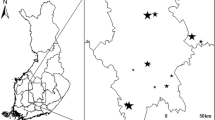Abstract
Wood-rotting fungi are major organisms exploiting coarse woody debris (CWD) in forests. Here, guild structure of wood-rotting fungi was investigated in cool temperate (Chichibu) and warm temperate (Chiba) forests in central Japan, based on their occurrence on CWD of different volumes and decay stages. Analysis with the program partitioning around medoids (PAM) recognized two clusters in Chichibu and four in Chiba, and their silhouette coefficients (an index for reliability of clustering) were adequately high, suggesting the existence of non-random clustering structure. To examine whether the clustering structure observed in this study was based on fungal preference for CWD or discontinuities in the distribution of CWD characteristics (decay stage and volume), null model analyses were made in which all fungal species were randomly redistributed among CWD. Silhouette coefficients based on the null model were reasonably high in both localities, indicating the observed clustering structure was at least partly attributable to the discontinuity in the distribution of CWD characteristics. In addition, the silhouette coefficient of the observed clustering structure was significantly higher than that of the null model in both localities. This result suggests that guild structure was present in the wood-rotting fungal communities, and the difference in CWD preference among wood-rotting fungi contributed to the structuralization of the communities.



Similar content being viewed by others
References
Allen RB, Buchanan PK, Clinton PW, Cone AJ (2000) Composition and diversity of fungi on decaying logs in a New Zealand temperate beech (Northfagus) forest. Can J Forest Res 30:1025–1033
Boddy L, Watkinson SC (1995) Wood decomposition, higher fungi, and their role in nutrient redistribution. Can J Bot 73(Suppl):S1377–S1383
Bradley RA, Bradley DW (1985) Do non-random patterns of species in niche space imply competition? Oikos 45:443–446
Garrison LP, Link JS (2000) Dietary guild structure of the fish community in the northeast United States continental shelf ecosystem. Mar Ecol Progress Series 202:231–240
Gaskett AC, Bulman C, He X, Goldsworthy SD (2001) Diet composition and guild structure of mesopelagic and bathypelagic fishes near Macquarie Island, Australia. N Z J Mar Freshwater Res 35:469–476
Hairston NG (1981) An experimental test of a guild: salamander competition. Ecology 62:65–72
Haromon ME, Franklin JF, Sollins P, Gregory SV, Lattin JD, Anderson NH, Cline SP, Aumen NG, Sedell JR, Lienkamper GW, Cromack K Jr, Cummins KW (1986) Ecology of coarse woody debris in temperate ecosystems. Adv Ecol Res 15:133–302
Heering JH, Nokoe S, Jemal M (1996) The classification of a Sesbania sesban (ssp. sesban) collection. I. Morphological attributes and their taxonomic significance. Trophic Grasslands 30:206–214
Jaksic FM (1981) Abuse and misuse of the term “guild” in ecological studies. Oikos 37:397–400
Kaji M (2000) Investigation on forest ecosystem in long term ecological research plot (tentative translation). Report of Scientific Research Fund
Kaufman L, Rousseeuw PJ (1990) Finding groups in data. Wiley, New York
Larsen MJ, Jurgensen MF, Harvey AF (1978) N2 fixation associated with wood decayed by some common fungi in western Montana. Can J Forest Res 8:341–345
Mæsset E (1999) Relationship between relative wood density of Picea abies logs and simple classification systems of decayed coarse woody debris. Scan J Forest Res 14:454–461
McCarthy BC, Bailey RR (1994) Distribution and abundance of coarse woody debris in a managed forest landscape of central Appalachians. Can J Forest Res 24:1317–1329
Molina R, Pilz D, Smith J, Dunham S, Dreisbach T, O’Dell T, Castellano M (2001) Conservation and management of forest fungi in the Pacific Northwestern United States: an integrated ecosystem approach. In: Fungal conservation: issues and solutions. Cambridge University Press, New York, pp19–63
Munoz AA, Ojeda FP (1997) Feeding guild structure of a rocky intertidal fish assemblage in central Chile. Env Biol Fishes 49:471–479
Munoz AA, Ojeda FP (1998) Guild structure of carnivorous intertidal fishes of the Chilean coast: implications of ontogenetic dietary shifts. Oecologia 114:563–573
Pianka ER (1980) Guild structure in desert lizards. Oikos 35:194–201
Pyle C, Brown MM (1999) Heterogeneity of woody decay classes within hardwood logs. Forest Ecol Manage 114:253–259
ADM Rayner L Boddy (1988) Fungal Decomposition of Wood Wiley Chichester, UK
Root RB (1967) The niche exploitation pattern of the blue-gray gnatcatcher. Ecol Monogr 37:317–350
Rousseeuw PJ (1987) Silhouettes: a graphical aid to the interpretation and validation of cluster analysis. J Comput Appl Math 20:53–65
Rubino DL, McCarthy BC (2003) Composition and ecology of macrofungal and myxomycete communities on oak woody debris in a mixed-oak forest Ohio. Can J Forest Res 33:2151–2163
Shoener Th W, Adler GH (1991) Greater resolution of distributional complementarities by controlling for habitat affinities: a study with Bahamanian lizards and birds. Am Nat 137:669–692
Sollins P (1982) Input and decay of coarse woody debris in coniferous stands in western Oregon and Washington. Can J Forest Res 12:18–28
Stockland JN (2001) The coarse woody debris profile: an archive of recent forest history and an important biodiversity indicator. Ecol Bull 49:71–83
Stone JM, Mackinnon A, Parminter JV, Lertzman KP (1998) Coarse woody debris decomposition documented over 65 years on southern Vancouver Island. Can J Forest Res 28:788–793
Struyf A, Hubert M, Rousseeuw PJ (1997) Integrating robust clustering techniques in S-PLUS. Comput Stat Data Anal 26:17–37
Uetz GW (1999) Guild structure of spiders in major crops. J Arachnol 27:270–280
Zimmerman JK, Pulliam WM, Lodge DJ, Quinones-Orfila V Waide RB (1995) Nitrogen immobilisation by decomposing woody debris and the recovery of wet tropical forest from hurricane damage. Oikos 72:314–322
Acknowledgements
We thank Dr. M. T. Kimura for his valuable contributions to the manuscript. We also thank Dr. N. Matushita for his help in identification of wood-rotting fungi and the staffs of the Chichibu and Chiba experimental forests for their help in field work.
Author information
Authors and Affiliations
Corresponding author
About this article
Cite this article
Takahashi, K.H., Kagaya, T. Guild structure of wood-rotting fungi based on volume and decay stage of coarse woody debris. Ecol Res 20, 215–222 (2005). https://doi.org/10.1007/s11284-004-0025-6
Received:
Accepted:
Published:
Issue Date:
DOI: https://doi.org/10.1007/s11284-004-0025-6




